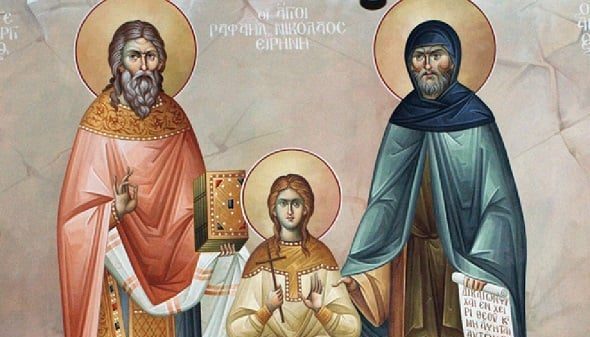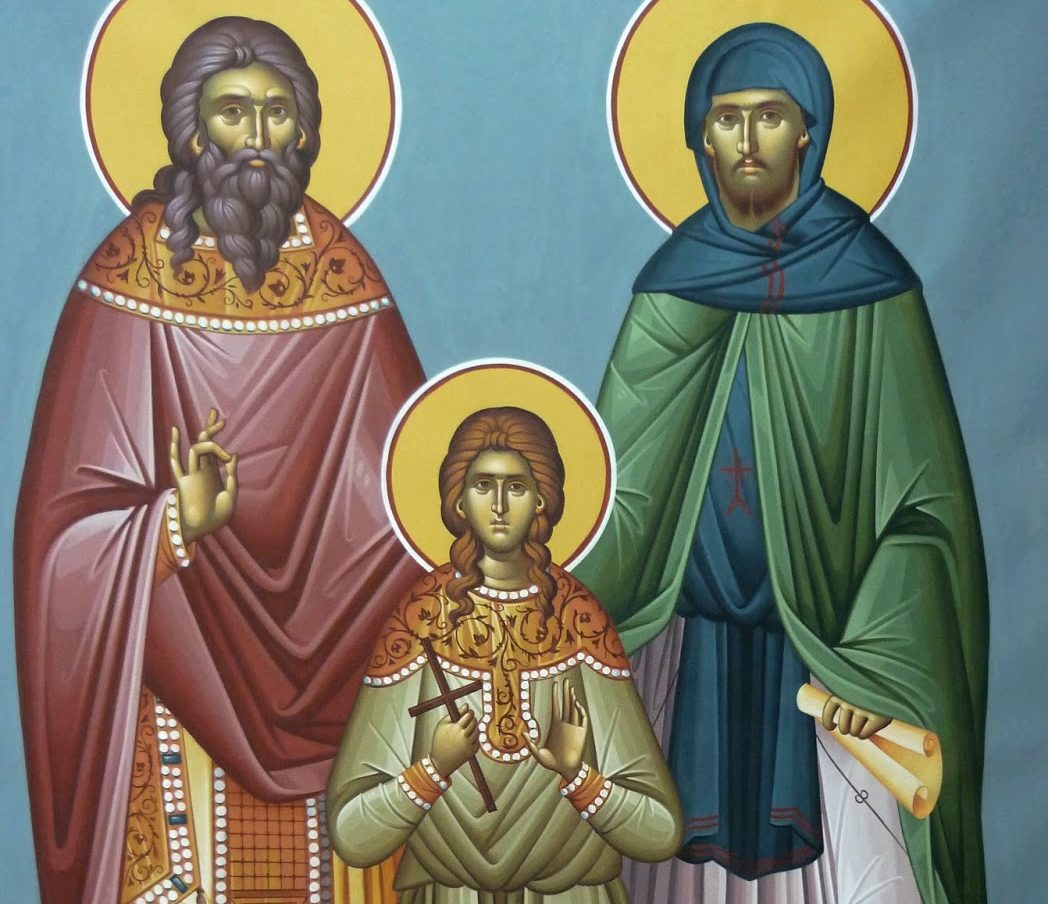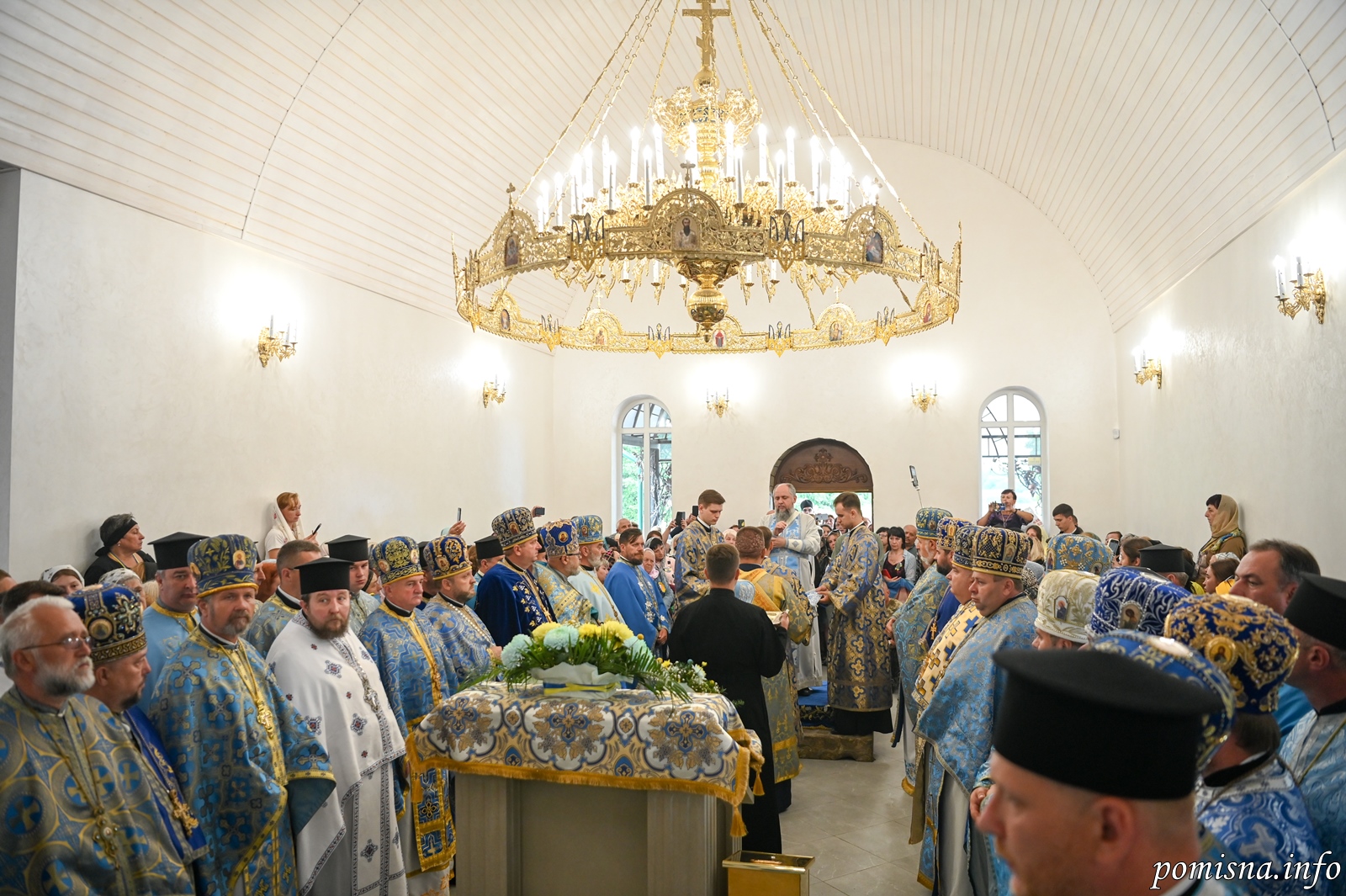Bright Tuesday: The Commemoration of Saints Raphael, Nicholas, Irene, and the Other Newly-revealed Martyrs of Lesbos


On the island of Mytilene (Lesbos in ancient times), near the village of Therme, the villagers had a custom of ascending a certain hill on this day to celebrate the Divine Liturgy in the ruins of a small chapel, although no one knew whence the tradition sprang. In the year 1959, certain villagers began seeing persons who spoke to them, first in dreams, then awake, both by day and by night.
Through these wondrous appearances, which were given to many people independently, the holy Martyrs Raphael, Archimandrite of the ancient monastery, and Nicholas, his deacon, together with other Saints who had been martyred on the island, told the villagers the whole account of their martyrdom, which had taken place at the hands of the Moslem Turks ten years after the fall of Constantinople, in 1463. The twelve-year-old Irene had been tortured, then burned alive in a large earthenware jar in the presence of her parents.
On Tuesday of Renewal Week, Saint Raphael had been tied to a tree and his head sawn off through his jaws; Saint Nicholas had died at the sight of this. Although the feast is celebrated today because it is the day of their martyrdom, through the appearances of the Saints as living persons five hundred years after their martyrdom, it is also a singular testimony to the Resurrection of Christ.
The Newly-Appeared Martyrs of Lesbos, Saints Raphael, Nicholas and Irene These Saints were martyred by the Turks on Bright Tuesday (April 9, 1463) ten years after the Fall of Constantinople. For nearly 500 years, they were forgotten by the people of Lesbos, but “the righteous Judge… opened the things that were hid” (2 Maccabees 12:41). For centuries the people of Lesbos would go on Bright Tuesday to the ruins of a monastery near Thermḗ, a village northwest of the capital, Mytilene. As time passed, however, no one could remember the reason for the annual pilgrimage. There was a vague recollection that once there had been a monastery on that spot, and that the monks had been killed by the Turks.
In 1959, a pious man named Angelos Rallis decided to build a chapel near the ruins of the monastery. On July 3 of that year, workmen discovered the relics of Saint Raphael while clearing the ground. Soon, the Saints began appearing to various inhabitants of Lesbos and revealed the details of their lives and martyrdom. These accounts form the basis of Photios Kontoglou’s 1962 book A Great Sign (in Greek).
Saint Raphael was born on the island of Ithaka around 1410, and was raised by pious parents. His baptismal name was George, but he was named Raphael when he became a monk. He was ordained to the holy priesthood, and later attained the offices of Archimandrite and Chancellor.
In 1453, Saint Raphael was living in Macedonia with his fellow monastic, Deacon Nicholas, a native of Thessaloniki. In 1454, the Turks invaded Thrace, so the two monks fled to the island of Lesbos. They settled in the Monastery of the Nativity of the Theotokos near Thermi, where Saint Raphael became the Igoumen.
In the spring of 1463, the Turks raided the monastery and captured the monks. They were tortured from Holy Thursday until Bright Tuesday. Saint Raphael was tied to a tree, and the ferocious Turks sawed through his jaw, killing him. Saint Nicholas was also tortured, and he died while witnessing his Elder’s martyrdom. He appeared to people and indicated the spot where his relics were uncovered on June 13, 1960.


Saint Irene was the twelve-year-old daughter of the village mayor, Basil. She and her family had come to the monastery to warn the monks of the invasion. The cruel Hagarenes cut off one of her arms and threw it down in front of her parents. Then the pure virgin was placed in a large earthen cask and a fire was lit under it, suffocating her within. These torments took place before the eyes of her parents, who were also put to death. Her grave and the earthen cask were found on May 12, 1961 after Saints Raphael, Nicholas and Irene had appeared to people and told them where to look.
Others who received the crown of martyrdom on that day were Basil and Maria, the parents of Saint Irene; Theodore, the village teacher; and Eleni, the fifteen-year-old cousin of Saint Irene.
The Saints appeared separately and together, telling people that they wished to be remembered. They asked that their icon be painted, that a Church Service be composed for them, and they indicated the place where their holy relics could be found. Based on the descriptions of those who had seen the Saints, the master iconographer Photios Kontoglou painted their icon. The ever-memorable Father Gerasimos of Little Saint Anne Skete on Mount Athos composed their Church Service.
Many miracles have taken place on Lesbos, and throughout the world. These Saints hasten to help those who invoke them, healing the sick, consoling the sorrowful, granting relief from pain, and bringing many unbelievers and impious individuals back to the Church.
Saint Raphael is tall, middle-aged, and has a beard of moderate length. His hair is black with some grey in it. His face is majestic, expressive, and filled with heavenly grace. Saint Nicholas is short and thin, with a small blond beard. He stands before Saint Raphael with great respect. Saint Irene usually appears with a long yellow dress reaching to her feet. Her blonde hair is divided into two braids which rest on either side of her chest.
Saints Raphael, Nicholas, and Irene (and those with them) are also commemorated on Bright Tuesday. Dr. Constantine Cavarnos has given a detailed account of their life, miracles, and spiritual counsels in Volume 10 of his inspirational series Modern Orthodox Saints (Belmont, MA, 1990).
Apolytikion of Renewal Tues.
Fourth Tone
On Lesbos, ye strove in contest for the sake of Christ God; ye also have hallowed her with the discovery of your relics, O blessed ones. O God-bearer Raphael, with thee, we all honour Nicholas the deacon and Irene the chaste virgin, as our divine protectors, who now intercede with the Lord.
Kontakion of Renewal Tues.
Plagal of the Fourth Tone
Ye shone on the world like stars first as ascetics, then as athletes slain for Christ, and were translated to the heights through the great torments that ye endured; and them that praise you, ye keep and protect, O Saints.
Source: goarch.org




